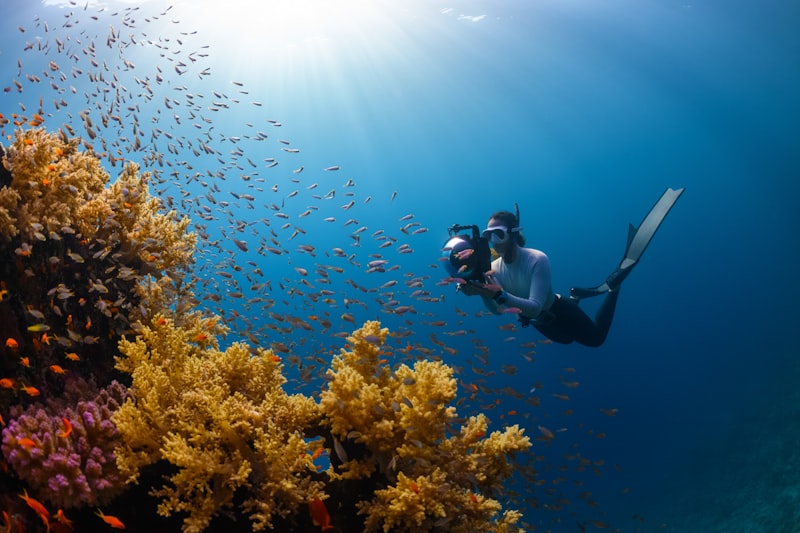At its core, biodiversity is the foundation of life on Earth. It encompasses the variety of life forms, their genes, habitats, and ecosystems. Nature’s role in conservation is fundamental because it provides the essential conditions for species to thrive. Healthy ecosystems regulate climate, purify air and water, control pests, pollinate crops, and recycle nutrients. They are the invisible hand that sustains life’s delicate balance, ensuring the survival of species, including humans.
Consider a forest as a bustling city where each species has a specific role: the trees are the skyscrapers providing shelter and producing oxygen, while fungi act as underground networks connecting and nourishing the community. Birds and insects are like the city’s inhabitants, pollinating flowers and dispersing seeds as they move from place to place. Every interaction and connection within nature contributes to the richness and resilience of the ecosystem.
Conserving biodiversity means protecting these intricate relationships and the habitats that support them. It involves preserving not just individual species but entire ecosystems and landscapes. When we safeguard nature, we preserve its ability to adapt to changing conditions, such as climate change and human activities, ensuring that future generations can continue to benefit from its resources and beauty.
Ultimately, the role of nature in biodiversity conservation is about recognizing its intrinsic value and interconnectedness with all life. By embracing our responsibility as stewards of the Earth, we can work towards sustainable practices that support biodiversity, promote resilience, and ensure a thriving planet for generations to come.
Beyond Boundaries: How Natural Ecosystems Drive Biodiversity Conservation
In the realm of biodiversity conservation, natural ecosystems are more than just landscapes; they are dynamic, living entities that evolve and adapt over time. They provide a myriad of ecosystem services essential for human survival, such as clean air, fresh water, and fertile soil. But their true significance lies in their ability to sustain life in its diverse forms.
Consider a rainforest teeming with life—every plant, insect, bird, and mammal intertwined in a complex dance of survival. Here, the richness of species ensures genetic diversity, which is the cornerstone of adaptation and resilience against environmental changes. It’s like a tapestry where each thread represents a different species, contributing to the beauty and strength of the whole.
Moreover, natural ecosystems act as natural buffers against climate change, absorbing carbon dioxide and regulating local climates. They are nature’s laboratories, where millions of years of evolution have crafted solutions to challenges we are only beginning to understand. Protecting these ecosystems isn’t just about preserving picturesque landscapes; it’s about safeguarding our own future.
So, when we talk about biodiversity conservation, we are essentially talking about preserving these intricate ecosystems and the wealth of life they support. It’s about recognizing that our well-being is intricately connected to the well-being of nature itself. By respecting the boundaries of these ecosystems and understanding their interconnectedness, we can ensure a sustainable future where biodiversity thrives and continues to amaze us with its resilience and beauty.
Nature’s Blueprint: Harnessing Ecosystems for Sustainable Biodiversity
Have you ever marveled at the intricate balance of a forest ecosystem, where each plant, animal, and microorganism plays a crucial role in maintaining harmony? Nature’s blueprint is a masterpiece of sustainable biodiversity, where every element is interconnected in a delicate dance of life. This concept isn’t just poetry; it’s a practical approach that scientists and conservationists are increasingly turning to for solutions to environmental challenges.
In essence, biodiversity refers to the variety of life forms within an ecosystem. It encompasses everything from the tiniest bacteria to the towering trees, each contributing to the resilience and productivity of the whole system. Imagine an orchestra where every instrument has its unique part to play, creating a symphony that transcends individual sounds—that’s biodiversity in action.
Why is harnessing ecosystems crucial for sustainable biodiversity? Picture a jigsaw puzzle: each piece represents a species, and the completed puzzle represents a healthy ecosystem. When one piece goes missing, the picture is incomplete. Ecosystems provide essential services like clean air, water purification, pollination, and climate regulation. By preserving and restoring these natural systems, we not only protect wildlife but also secure these vital services for ourselves and future generations.
Conservation efforts often focus on preserving iconic species like tigers or elephants, but sustainable biodiversity goes beyond charismatic megafauna. It involves safeguarding habitats, restoring degraded lands, and promoting sustainable practices in agriculture, fisheries, and forestry. For example, agroforestry combines trees with crops to mimic natural forest ecosystems, enhancing soil fertility and biodiversity while providing livelihoods for communities.
The concept of harnessing ecosystems for sustainable biodiversity isn’t just theoretical; it’s being put into practice worldwide. From rewilding projects in Europe to community-led conservation efforts in Africa, innovative approaches are emerging to restore ecosystems and ensure they thrive. It’s about working with nature rather than against it, recognizing that our well-being is intricately linked to the health of the planet.
As we face pressing global challenges like climate change and biodiversity loss, the importance of nature’s blueprint becomes clearer than ever. By understanding and respecting the intricate web of life that sustains us, we can forge a path towards a more sustainable and resilient future.
Unveiling Nature’s Secrets: Key Players in Biodiversity Preservation
Imagine a forest where each plant, animal, and microorganism plays a crucial role. Just like a symphony, where every note contributes to the harmonious whole, biodiversity relies on the synergy of its participants. From the mighty elephants shaping landscapes to the humble bees pollinating flowers, each species is a thread in the fabric of life.
Take the coral reefs, vibrant cities beneath the waves. Here, fish of all colors dance among corals, contributing to the ocean’s health and resilience. They are architects of their environment, creating homes for countless marine creatures. Yet, these reefs are fragile, threatened by climate change and human activity.
In the lush rainforests, biodiversity is on grand display. Here, jaguars stealthily prowl, regulating prey populations to maintain the forest’s balance. Meanwhile, birds spread seeds that germinate into the next generation of trees, perpetuating the cycle of life.
Zoom out to the global scale, where migratory birds traverse continents, connecting distant habitats and influencing ecosystems thousands of miles apart. Their journeys remind us of nature’s interconnectedness, where actions in one place ripple across the planet.

Preserving biodiversity means understanding and respecting these intricate relationships. It means safeguarding habitats, combating climate change, and adopting sustainable practices. By protecting keystone species—the linchpins of their ecosystems—we secure the web of life that sustains us all.
From Forests to Oceans: Exploring Nature’s Crucial Role in Conservation Efforts
Moving towards the oceans, these vast bodies of water cover over 70% of the Earth’s surface and support an incredible array of life forms. From microscopic plankton to majestic whales, marine ecosystems sustain biodiversity on a grand scale. Coral reefs, often referred to as the rainforests of the sea, are hotspots of marine biodiversity and contribute significantly to global fisheries and tourism.
Conservation efforts aimed at preserving these natural wonders are multifaceted. They involve establishing protected areas, sustainable forestry practices, and international agreements to combat climate change and ocean pollution. Education and public awareness also play a crucial role in fostering a deeper appreciation for nature’s contributions and inspiring collective action.
As we delve deeper into understanding the interconnectedness of ecosystems, it becomes clear that protecting nature is not just an environmental issue but a matter of survival. Every tree felled in the Amazon or piece of plastic dumped into the ocean has ripple effects that extend far beyond local boundaries. By recognizing the value of nature in economic, ecological, and cultural terms, we can forge a path towards a sustainable future where humans and wildlife thrive together.
Nature’s role in conservation efforts is indispensable. From the depths of the rainforests to the expanses of the ocean, each ecosystem contributes uniquely to the health of our planet. By embracing sustainable practices and advocating for conservation, we can ensure that future generations inherit a world rich in biodiversity and natural beauty.
Balance of Life: The Intrinsic Link Between Natural Habitats and Biodiversity
Take, for instance, the lush rainforests of the Amazon basin. These verdant expanses are not just a collection of trees but a bustling hub of biodiversity. Countless species of plants, animals, and insects call these forests home, each contributing uniquely to the ecosystem’s stability. The intricate dance between predator and prey, pollinator and flower, creates a tapestry of life that is both resilient and fragile.

Beyond the forests, coral reefs in the oceans act as vibrant underwater cities. Coral polyps, tiny organisms with immense ecological significance, build intricate calcium carbonate structures that house a myriad of marine life forms. From colorful fish to majestic sea turtles, each species relies on the reef for protection, food, and reproduction. The health of coral reefs is not just a concern for marine biologists but a barometer of the ocean’s overall well-being.
However, the link between natural habitats and biodiversity is facing unprecedented challenges. Human activities such as deforestation, pollution, and climate change threaten to unravel this delicate balance. As forests shrink and oceans warm, species face habitat loss and fragmentation, pushing many to the brink of extinction.
Yet, amidst these challenges lies hope. Conservation efforts, community-driven initiatives, and sustainable practices are paving the way for a harmonious coexistence between humans and nature. By understanding the intrinsic link between natural habitats and biodiversity, we can forge a path towards a future where the balance of life is not only preserved but thriving.
The balance of life intricately woven between natural habitats and biodiversity underscores the urgency of our stewardship of the Earth. Each decision we make, from individual choices to global policies, shapes the future of our planet’s rich tapestry of life.
Nature’s Guardians: How Wildlife and Plants Safeguard Global Biodiversity
Imagine a world without the diverse array of plants and wildlife that inhabit our planet. From the towering rainforests of the Amazon to the vast savannas of Africa, these ecosystems are not just breathtakingly beautiful but essential to maintaining global biodiversity. But what exactly does biodiversity mean? It’s the intricate web of life on Earth, encompassing every species of plant, animal, and microorganism, each playing a crucial role in maintaining a balanced and healthy environment.
Let’s start with wildlife. Animals, both big and small, act as key players in the biodiversity game. Take the bees, for instance. These tiny yet mighty creatures are responsible for pollinating flowers, ensuring the reproduction of plants that form the basis of many food chains. Without bees, crops would fail, and entire ecosystems could collapse like a house of cards. It’s not just about bees though; every animal, whether it’s a predator at the top of the food chain or a scavenger cleaning up the mess, contributes uniquely to the stability of their habitat.
Plants, on the other hand, are the unsung heroes of biodiversity. They not only provide food and shelter for countless organisms but also produce oxygen through photosynthesis, which is vital for the survival of nearly every living being on Earth. Think of them as the green lungs of our planet, constantly working behind the scenes to purify the air we breathe and regulate our climate.

Together, wildlife and plants form a dynamic duo that acts as nature’s guardians, preserving biodiversity against the onslaught of human activities such as deforestation, pollution, and climate change. When we protect wildlife habitats and conserve plant species, we are not just saving individual creatures or plants; we are safeguarding entire ecosystems and the services they provide to humanity.
The interconnectedness of wildlife and plants in maintaining global biodiversity is a marvel of nature. As stewards of this planet, it is our responsibility to cherish and protect these invaluable resources for future generations.
Eco-Warriors of the Earth: How Natural Areas Champion Biodiversity
Imagine walking through a dense, ancient forest where towering trees embrace you with their moss-covered limbs, and the air hums with the symphony of unseen creatures. Such places are not only awe-inspiring but essential to our existence. Natural areas, untouched by human development, provide refuge for countless species, from the majestic Bengal tiger to the diminutive orchids that bloom hidden away.
These sanctuaries act as havens for genetic diversity, ensuring that species can adapt to changing environmental conditions. For example, in the depths of the Amazon rainforest, researchers continue to discover new species, each a testament to nature’s boundless creativity. By preserving these habitats, we safeguard the potential for future medical breakthroughs, as many plants and animals hold secrets that could revolutionize medicine.
Moreover, natural areas play a crucial role in mitigating climate change. Forests, for instance, act as carbon sinks, absorbing carbon dioxide from the atmosphere and helping to regulate global temperatures. Wetlands filter water, purifying it for both wildlife and human consumption. These ecosystems provide invaluable ecosystem services that benefit all life on Earth.
Yet, these sanctuaries are under threat. Deforestation, pollution, and climate change pose significant challenges to their survival. As stewards of the Earth, it is our responsibility to protect and restore these natural areas. Through conservation efforts, sustainable practices, and education, we can ensure that future generations inherit a planet teeming with life and wonder.
Frequently Asked Questions
What is the importance of natural habitats in biodiversity conservation?
Learn about the crucial role of natural habitats in preserving biodiversity. Understand why these habitats are essential for supporting diverse species, maintaining ecological balance, and safeguarding our ecosystems for future generations.
Why are keystone species crucial for biodiversity conservation?
Learn why keystone species are vital for biodiversity conservation and ecosystem stability.
How do ecosystems contribute to maintaining biodiversity?
Discover how ecosystems play a crucial role in maintaining biodiversity through intricate interactions between species and their environments. Learn about the various ways ecosystems support diverse life forms and ensure ecological balance.
How does habitat fragmentation impact biodiversity?
Learn how habitat fragmentation affects biodiversity. Understand the consequences of fragmented habitats on species survival, genetic diversity, and ecosystem stability.
What are the benefits of natural corridors in biodiversity conservation?
Discover the advantages of natural corridors in biodiversity conservation. Learn how these pathways promote species movement, genetic diversity, and ecosystem resilience. Understand their role in mitigating habitat fragmentation and enhancing wildlife survival.


